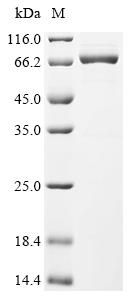Recombinant Human cytomegalovirus Immediate early protein IE1 (UL123) is expressed in E.coli and includes the complete sequence spanning amino acids 1-491. The protein features an N-terminal 10xHis-tag and a C-terminal Myc-tag that make purification and detection more straightforward. Purity levels appear to exceed 90% based on SDS-PAGE verification, which suggests good reliability for research work. Endotoxin levels have been kept low to help maintain experimental integrity.
The Immediate early protein IE1 from Human cytomegalovirus seems to play a central role in viral replication and immune evasion. This regulatory protein is likely involved in changing host cell processes to favor viral persistence and spread. IE1 has drawn considerable interest in virology research, particularly for studying how hosts and pathogens interact and understanding the mechanisms behind viral latency and reactivation.
Potential Applications
Note: The applications listed below are based on what we know about this protein's biological functions, published research, and experience from experts in the field. However, we haven't fully tested all of these applications ourselves yet. We'd recommend running some preliminary tests first to make sure they work for your specific research goals.
Based on the provided information, the recombinant Human cytomegalovirus Immediate early protein IE1 is expressed in E. coli, a prokaryotic system that is generally unsuitable for correctly folding complex eukaryotic viral proteins. IE1 is a multifunctional protein that likely requires specific post-translational modifications (e.g., phosphorylation) and proper folding for its native structure and bioactivity, which E. coli cannot provide. The presence of dual tags (N-terminal 10xHis and C-terminal Myc) may further interfere with folding. Although the protein is full-length (1-491aa), the lack of activity validation means it is highly probable that the protein is misfolded and inactive. Therefore, without experimental confirmation, it cannot be assumed to be correctly folded or bioactive.
1. Antibody Development and Validation Studies
This recombinant IE1 protein can be used as an immunogen for antibody generation, as antibodies may recognize linear epitopes independent of folding. The dual tags facilitate purification and detection in assays like ELISA or Western blot. However, if the protein is misfolded (as is likely), the resulting antibodies may not bind the native, post-translationally modified IE1 in viral contexts, limiting their utility for physiological studies. Antibody validation should include testing against native IE1 from infected cells.
2. Protein-Protein Interaction Studies
The dual tags enable immobilization for pull-down assays, but this application is highly unreliable if the protein is misfolded. IE1's interactions with host proteins depend on native conformation; a misfolded protein may yield non-physiological bindings or false negatives. The full-length sequence is advantageous, but the results would be invalid without folding validation. This application should be avoided unless correct folding is confirmed.
3. In Vitro Biochemical Assays
The protein can be used in biochemical assays (e.g., gel shift or stability tests), but if misfolded, outcomes like DNA-binding or post-translational modification studies will not reflect native functionality. The high purity reduces contamination, but assays require activity verification first. For example, DNA-binding assays may give false negatives if the protein is inactive.
4. Immunological Research Applications
This application is critically dependent on correct folding, as T-cell recognition requires native epitopes. If IE1 is misfolded, it may not stimulate cytomegalovirus-specific T-cells effectively, leading to false negatives in proliferation or cytokine assays. The protein is unsuitable as a vaccine antigen or immune standard without bioactivity confirmation. Use should be postponed until folding and immunogenicity are validated.
Final Recommendation & Action Plan
Given the high likelihood of misfolding due to E. coli expression, it is essential to prioritize folding and bioactivity validation before any application. Recommend performing biophysical analyses (e.g., circular dichroism for secondary structure, size-exclusion chromatography for oligomeric state) and functional assays (e.g., DNA-binding or co-immunoprecipitation with known partners) to confirm native conformation. If active, the protein can be used cautiously for the described applications; if inactive, limit use to antibody development for linear epitopes or as a denatured control. Always include native protein controls and consider alternative expression systems (e.g., mammalian cells) for activity-dependent studies.






